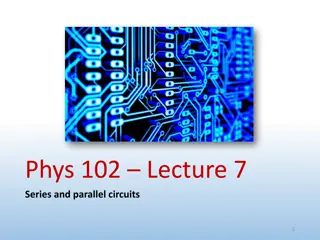Understanding Electricity and Circuits: Components, Cells, Batteries, and Ratings
Explore the fundamentals of electricity and circuits, including circuit components, cells, batteries, types of cells, primary vs. secondary cells, dry vs. wet cells, and ratings. Learn about the relevance of this knowledge in engineering and certifications like NABCEP PV Associate. Discover the workings of cells, batteries, and the importance of ratings in determining capacity. Enhance your understanding of electricity with this comprehensive course.
Download Presentation

Please find below an Image/Link to download the presentation.
The content on the website is provided AS IS for your information and personal use only. It may not be sold, licensed, or shared on other websites without obtaining consent from the author. Download presentation by click this link. If you encounter any issues during the download, it is possible that the publisher has removed the file from their server.
E N D
Presentation Transcript
Course 5 Electricity and Circuits
Objectives Circuit components Cells/batteries Loads Resistors Switches Wires Overcurrent Protection devices
Relevancy To understand the basics of electricity To promote an engineering mindset NABCEP PV Associate certification CVQ level 2
Cells An electrochemical device consisting of two electrodes made of different materials and an electrolyte Voltage is produced when a chemical reaction occurs between the electrodes and electrolyte
Battery Consists of two or more cells electrically connected together and packaged as a single unit Often used to refer to multi-cell or single cell
Types of Cells Lead-acid Nickel-cadmium (NiCd) Carbon-zinc Alkaline-manganese dioxide Lithium
Cells and Batteries Normally classified as primary or secondary Primary types have a non-reversible reaction Secondary types have a reversible reaction (rechargeable) Also classified as dry and wet cell Dry cells contain either a paste or gel electrolyte Wet cells must be used upright All batteries have an internal resistance
Primary vs Secondary Primary cells are single use Alkaline Carbon-zinc Rechargeable cells can be recharged Lithium-ion Lead-acid Nickel-cadmium
Cell Comparison These are some of the cells that you may come across in photovoltaics (Sailors for the Sea, 2016)
Ratings Capacity of a cell/battery is rated in ampere-hours (Ah) Capacity can change based on: Temperature Current drain Discharge schedule Final output voltage With a specified voltage, watt-hours can be calculated
Lighting Loads Incandescent CFL Miniature lamps LEDs Neon Fluorescent
Types of Resistors Carbon-composition Wire-wound Cermet Deposited-film Conductive-plastic Surface-mount
Switches SPST single pole single throw SPDT single pole double throw DPST double pole single throw DPDT double pole double throw Rotary
Wires and Cables Solid Stranded Romex Metallic TC Wire gauge
Protection Devices Fuses Circuit breakers Fuse resistor Voltage sensitive/voltage dependent resistor























